What's going on with comet Wirtanen?
Wirtanen's Lightcurve
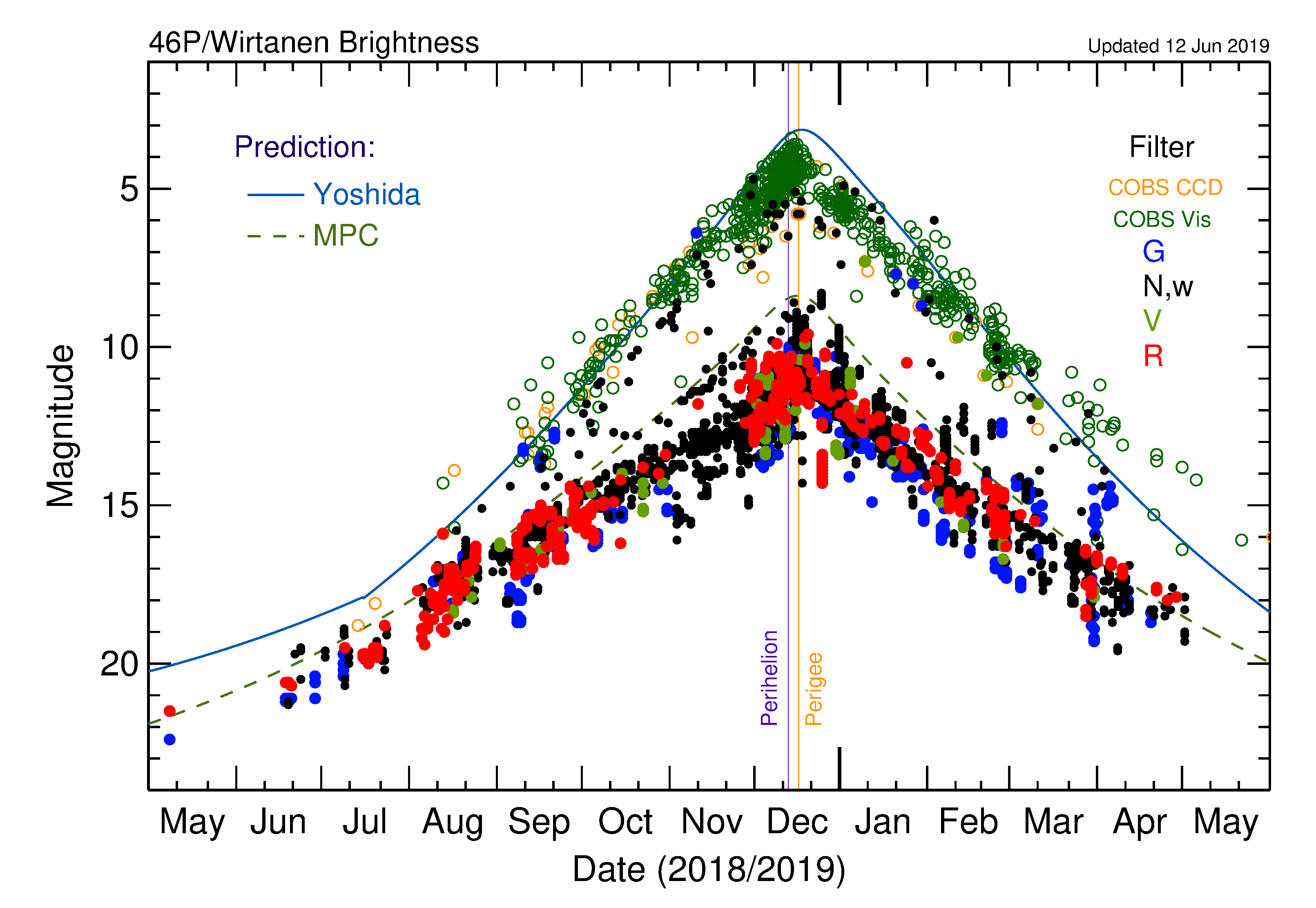
Lightcurve of comet Wirtanen (colored dots), compiled from observations reported to the Minor Planet Center1 (solid circles) and the Comet Observer's Database2 (open circles). Predicted magnitudes are current estimates from sources using different techniques, and have a wide variability. These will be updated as more recent observations help in constraining the projections. For more information about these predictions, see the Wirtanen brightness discussion.
Updates
25 Dec 2018
Wirtanen in the news
There have been a number of news articles reporting on observations of the comet and on scientific results that have been released. We are introducing our new Press report page that provides a list of links to these articles.
21 Dec 2018
Radar observations of the nucleus
Ellen Howell et al. report on the detection of the nucleus of comet Wirtanen using the Arecibo Observatory 10-18 Dec 2018. They derive a nucleus size 1400x1100 m and detect an extended, asymmetric skirt of large (>2 cm) grains in the coma. The image below shows the detection of the nucleus (spike) and the extended skirt of large grains surrounding it.
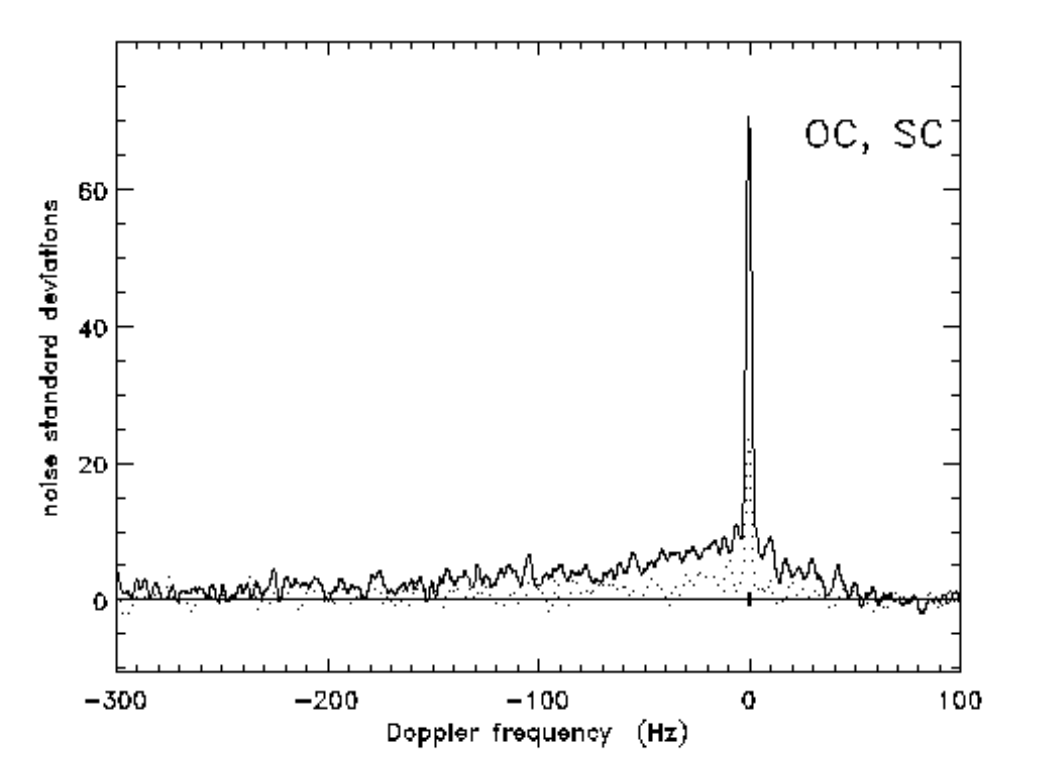
18 Dec 2018
Production Rates and a changing rotation period?
Dave Schleicher measured gas production using narrowband filter photometry on 16 Dec (r=1.06):
Q(OH)= 5.37E+27 mol/s (Haser)
Q(H2O)= 7.24E+27 mol/s (Vectorial)
Q(CN)= 1.17E+25 mol/s
Af(5260A) = 117 cm
Emannuel Jehin et al. report that a CN lightcurve measured from photometry obtained at the TRAPPIST telescopes on 9-10 Dec 2018 shows a 9.2 hr periodicity, which is assumed to reflect the rotation period of the nucleus.
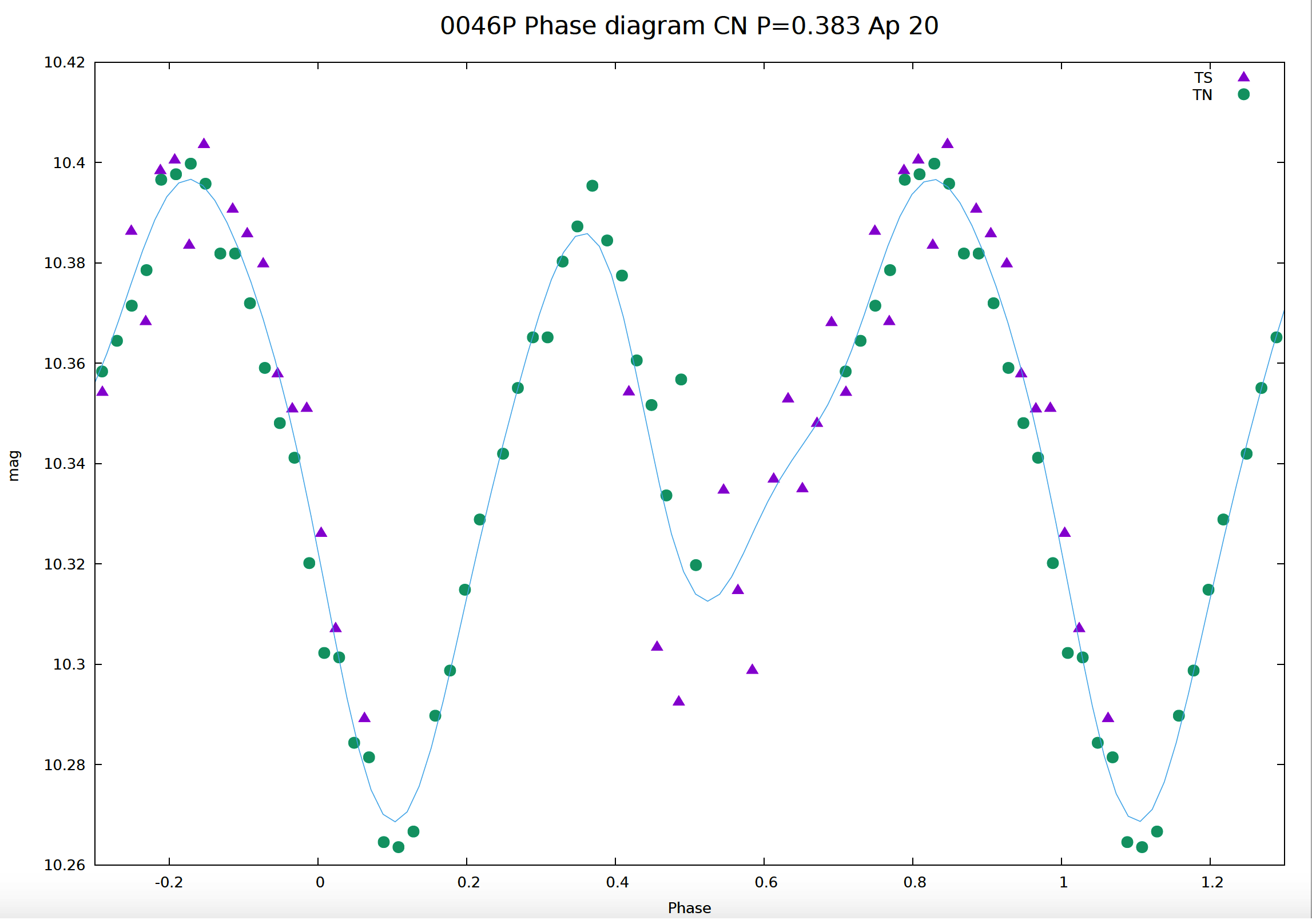
Tony Farnham and Lori Feaga are observing CN morphology at the Discovery Channel Telescope (15-17 Dec - See 15 Dec update) and report that attempts to phase the images to either the 8.9-hr period (CBET 4571) or the 9.2-hr period (above and CBET 4585) structure does not produce a smooth sequence of changes, even though the morphology does repeat multiple times over the period of observations. This may be indicating that the period is evolving with time.
15 Dec 2018
Rotational Variability
Observations from the Discovery Channel Telescope show the CN emission is continuing to exhibit rotational variability. A sequence of images shows the changes, though due to gaps in the temporal coverage, it is not truly representatinve of the rotational phasing.
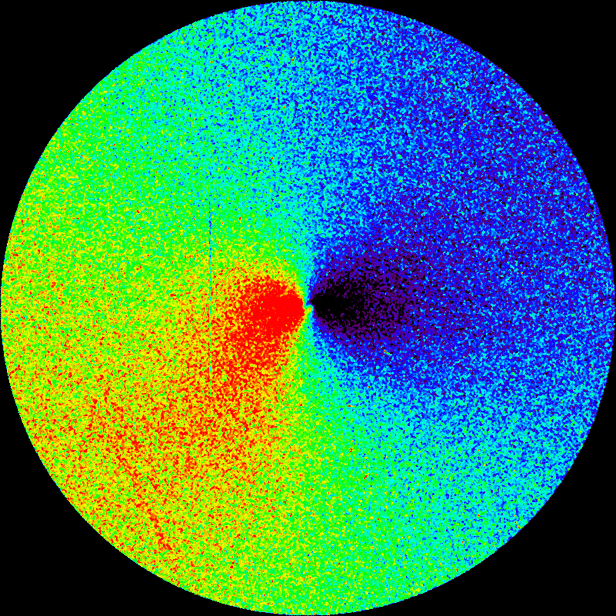
10 Dec 2018
Production Rates and a diffuse coma
Emmanuel Jehin reports: Production rates from TRAPPIST-S at 10,000 km using a Haser Model (Vp=Vd=1km/s). The dust production rate proxy Af(rho) was computed by profile fitting at 10,000 km. We also see clear variations of the flux during the night.
46P (Dec. 9, 2018 , r=1.06 au, delta=0.09 au):
----------------------------------------------
Q(C2)= 1.90E+25 +/- 2.52E+23 mol/s
Q(C3)= 4.33E+24 +/- 2.64E+23 mol/s
Q(CN)= 1.29E+25 +/- 2.94E+23 mol/s
Q(NH)= 3.36E+25 +/- 1.53E+24 mol/s
Q(OH)= 5.22E+27 +/- 1.22E+26 mol/s
Afro(BC) = 75 +/- 5 cm
He also provided a composite image that shows the diffuse nature of the comet's coma.
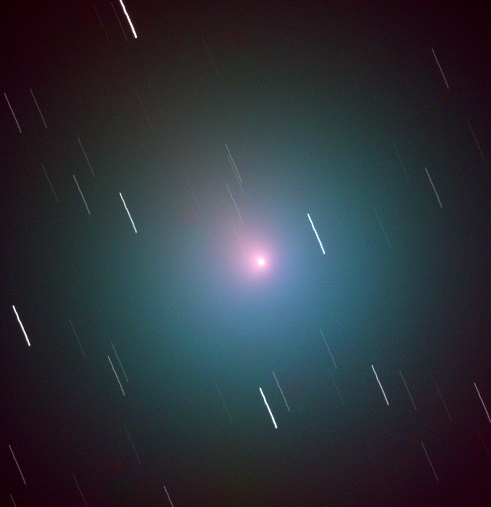
8 Dec 2018
HCN and Water Production Rates
Cordiner et al. (in prep) obtained interferometric observations of comet 46P/Wirtanen using the Atacama Large Millimeter/submillimeter Array (ALMA) on 2018-12-02. High-resolution spectral images were obtained of the rotational emission from various coma gases, including the bright HCN (J = 4-3) line. The HCN spatial distribution (shown in the right panel of this Figure) is strongly centrally-peaked, at a position consistent (within 0.2 arcsec) of the latest Horizons orbital solution (K181/6). The HCN spectral line profile (left panel) is double-peaked, with an enhanced blue lobe, indicative of preferential outgassing from the Earth-facing side of the nucleus. The HCN line FWHM of 1.4 km/s implies a coma outflow velocity of around 0.7 km/s.
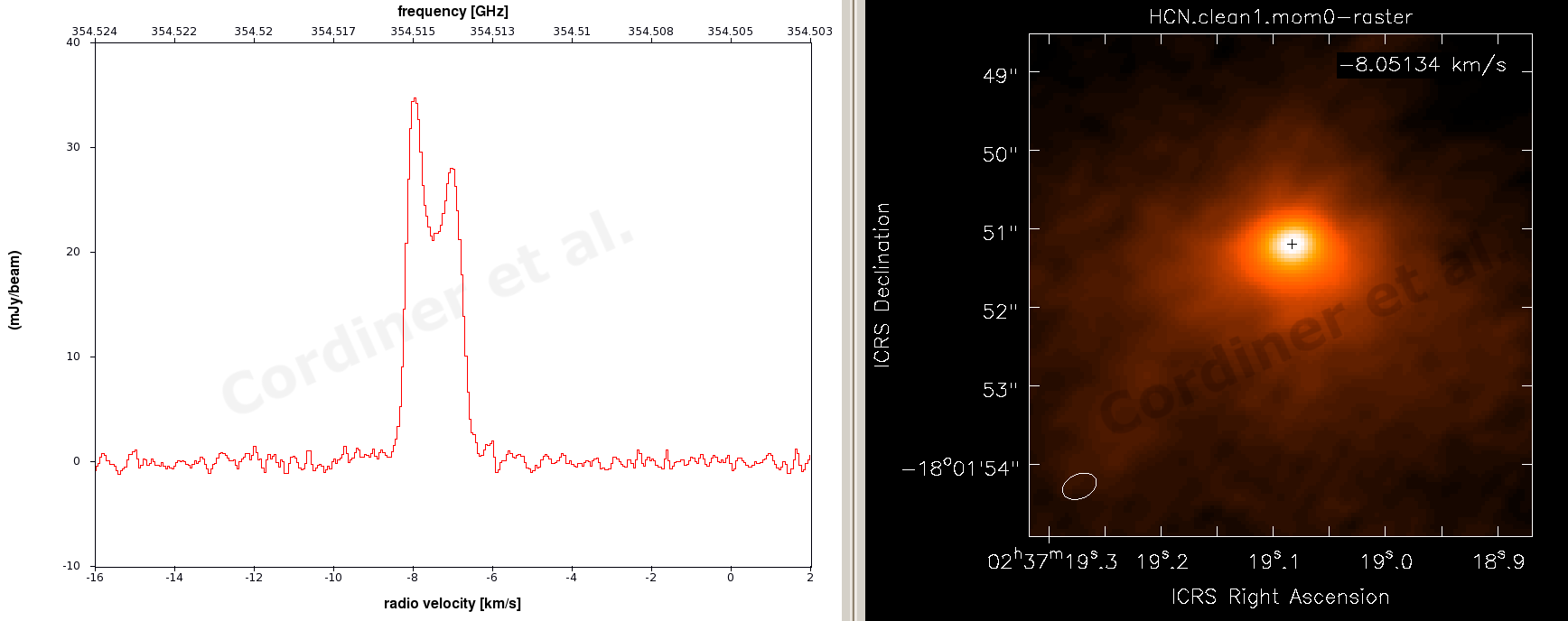
Dave Schleicher measured gas production using narrowband filter photometry on 3 Dec (r=1.06). Haser models give an OH production of Q(OH)=6.0×1027 molec/s. This converts to a water production rate of Q(H2O)=7.9×1027 molec/s. This suggests that the water production is consistent with that on previaous apparitions.
26 Nov 2018
Rotation and production rates
Farnham et al. (CBET 4571) report a rotation period of 8.91 hr, based on the coma morphology seen in CN (see figure). Repetition over at least eight rotations is consistent with a conjecture that the nucleus is in a state of simple rotation.
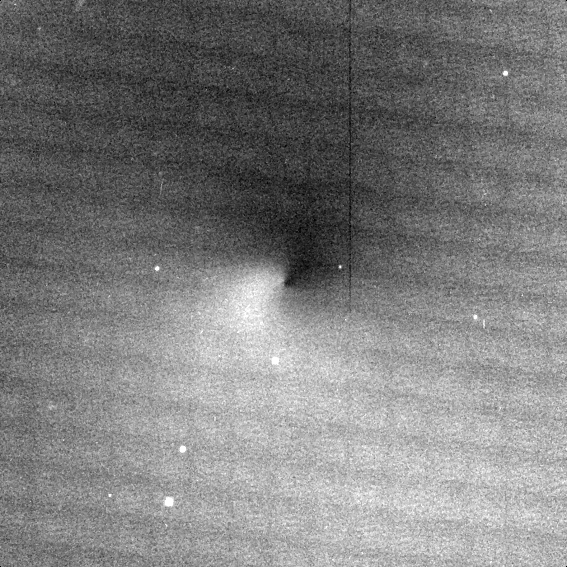
Dave Schleicher measured gas production using narrowband filter photometry on 7 and 15 November (r=1.16 & 1.12 AU). Haser models give an OH production of Q(OH)=4.9×1027 and 5.6×1027 molec/s. This converts to a water production rate of Q(H2O)=6.2×1027 and 7.2×1027 molec/s. This seems to be ~25% lower water production than on previous apparitions, though the discrepancy may be due to a large extrapolation from a relatively small fraction of the coma.
18 Oct 2018
Detection of water production
We have our first report of a water production rate for Wirtanen. Dave Schleicher detected OH using narrowband filter photometry on 6 October (r=1.38 AU). Haser models give an OH production of Q(OH)2.0×1027 molec/s. This converts to a water production rate of Q(H2O)=2.3×1027 molec/s.
Production rates for other species on the same date: Q(CN)4.5×1024 molec/s, Q(C2)6.3×1024 molec/s, and Afrho(5260A) = 20 cm.
With no comparable pre-perihelion measurements from previous apparitions, it is not clear whether Wirtanen is behaving as expected, or if changes are occurring on this apparition.
21 Sep 2018
Updates on brightness and Semrock CN filter tests
Recent visual observations are following the Yoshida prediction (which itself is derived from visual observations). This suggests that Wirtanen might still reach naked eye brightness. MPC magnitudes tend to be fainter because they are usually derived from smaller apertures.
Jorma Ryske performed tests with his own Semrock CN filter using a 12-inch telescope. By observing comet 21P/Giacobini-Zinner, he found that, with his larger telescope he was able to detect features in the CN coma. This could be promising for the close approach of comet Wirtanen. See the Semrock test page for more information.
4 Sep 2018
Brightness Update
Current trends indicate that Wirtanen is following the fainter level of predictions, which peak around mag 8 at closest approach. On previous appritions, it exhibited an upturn around this point in its orbit. Whether it follows this pattern in the next few weeks will provide a better constraint on how bright it might get.
14 Aug 2018
Current appearance
Images from Aug 9, 2018 were obtained when Wirtanen was at a heliocentric distance of 1.86 AU, geocentric distance of 1.09 AU, and had an R magnitude ~17. It shows a short tail to the WSW. The image is ~60,000 km across at the comet's distance
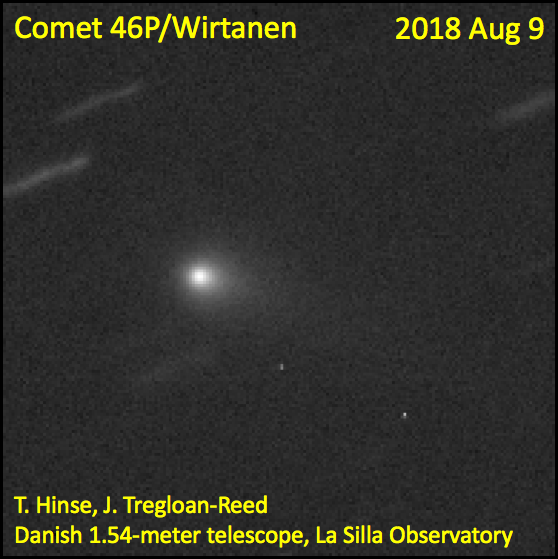
26 Jun 2018
Update/Correction on Wirtanen's recovery
On June 1, we reported that Wirtanen had been recovered (see June 1 report below). It turns out that the object that we reported in the May 8 images was a random asteroid (133655), that had nearly the same expected brightness and proper motion as Wirtanen, but was following ~77 arcsec behind the comet's predicted position.
On Jun 18, 19 and 20, Lori Feaga et al. (UMD) obtained observations of Wirtanen from the DCT. Astrometry from these observations, which were obtained under better conditions (2 airmass during astronomical twilight) than the May data, linked well to measurements from 2014. This confirmed that the June ID was actually Wirtanen, and proved that the May ID was not.
The June 18-20 images were obtained when Wirtanen was at a heliocentric distance of 2.28 AU, geocentric distance of 1.98 AU, and had an r' magnitude of 20.6. It shows a short tail (~5 arcsec) to the SSW (in the anti-solar direction, which also coincides with the direction opposite to the comet's velocity vector).
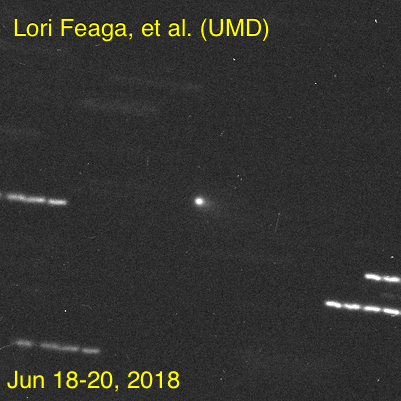
To re-visit the May 8 observations, we used Wirtanen's new orbit solution to look for the comet in those data, and found that it was close to the newly-predicted positions but barely detectable in individual frames. It became visible when all images were coadded, and is in fact, seen in the coadded image that we presented in our report from June 1.
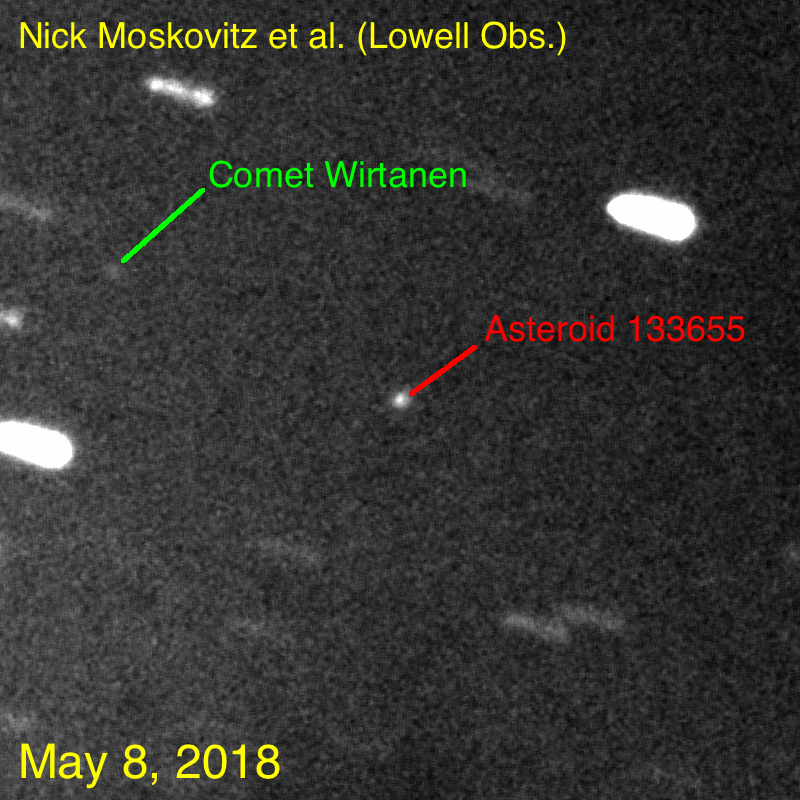
The new data indicate that Wirtanen is currently 1-1.5 mag fainter than predicted in both May and June. It is not yet clear how this will translate to the brightness around close approach to the Earth.
The updated orbit solution confirms that Wirtanen will make its close approach to the Earth at a distance of 0.0775 AU on December 16, 2018, at 13:29 UT. Additional astrometry is requested to continue to refine the orbit and constrain the effects of any non-gravitational forces.
1 Jun 2018
Comet Wirtanen has been recovered!
46P/Wirtanen was recovered on May 8, 2018 in images obtained by Nick Moskovitz (Lowell Observatory), in collaboration with Tony Farnham and Matthew Knight (University of Maryland). Six images of the comet were obtained at the Discovery Channel Telescope operated by Lowell Observatory. They were acquired during astronomical twilight at 4.5-5.1 airmass. A coadded version of the images is shown below.
At the time of the recovery, Wirtanen was at a heliocentric distance of 2.61 AU, geocentric distance of 2.80 AU, and had an r' magnitude of 20.3. There is no obvious coma visible in the images, but the comet's brightness suggests that it is already exhibiting activity.
The updated orbit solution confirms that Wirtanen will make its close approach to the Earth at a distance of 0.078 AU on December 16, 2018, but with only limited 2018 observations, the exact time of close approach has an uncertainty of several hours. Additional astrometry is requested to refine the orbit and constrain the effects of non-gravitational forces.
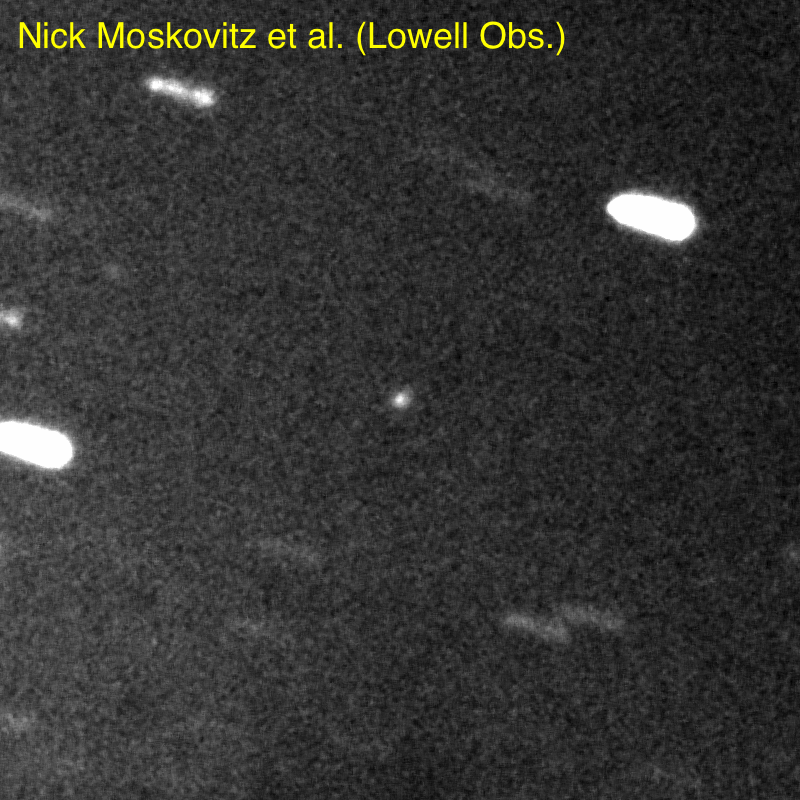
1. Thanks to the Minor Planet Center (MPC), operated by the Smithsonian Astrophysical Observatory (SAO) under the auspices of International Astronomical Union (IAU) for compiling brightness and astrometric measurements.↩
2. We acknowledge with thanks the comet observations from the COBS Comet Observation Database contributed by observers worldwide and used in this research.↩